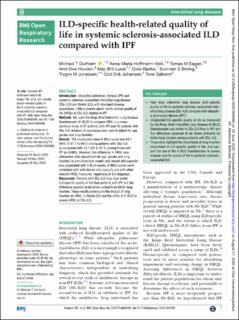ILD-specific health-related quality of life in systemic sclerosis-associated ILD compared with IPF
Durheim, Michael; Hoffmann-Vold, Anna-Maria; Eagan, Tomas Mikal; Hovden, Arnt-Ove; Samersaw-Lund, May Brit; Bjerke, Gisle; Birring, Surinder S.; Jonassen, Trygve Müller; Johansen, Odd Erik; Sjåheim, Tone Bjørg
Journal article, Peer reviewed
Published version

Åpne
Permanent lenke
https://hdl.handle.net/11250/2738389Utgivelsesdato
2020Metadata
Vis full innførselSamlinger
- Department of Clinical Science [2316]
- Registrations from Cristin [9748]
Sammendrag
Abstract
Introduction Idiopathic pulmonary fibrosis (IPF) and systemic sclerosis-associated interstitial lung disease (SSc-ILD) are fibrotic ILDs with divergent disease populations. Little is known about health-related quality of life (HRQL) in SSc-ILD relative to IPF.
Methods
We used the Kings Brief Interstitial Lung Disease Questionnaire (K-BILD) to compare HRQL in a cross-sectional study of 57 patients with IPF and 29 patients with SSc-ILD. Analysis of covariance was used to adjust for age, gender and lung function.
Results
The unadjusted mean K-BILD score was 63.1 (95% CI 57.1 to 69.1) among patients with SSc-ILD, as compared with 54.7 (51.8–57.5) among those with IPF (p=0.005). However, this difference in HRQL was attenuated after adjustment for age, gender and lung function. In a multivariable model, only forced vital capacity was associated with K-BILD scores. K-BILD scores were correlated with both forced vital capacity and with other relevant HRQL measures, regardless of ILD diagnosis.
Discussion
Patients with SSc-ILD may have better ILD-specific quality of life than patients with IPF, but this difference appears to be driven primarily by better lung function. These results underscore the impact of lung function on HRQL in fibrotic ILD and the utility of K-BILD to assess HRQL in SSc-ILD.
